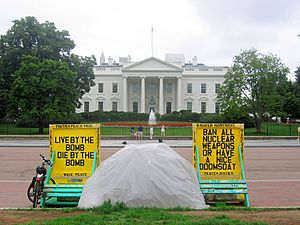Norman Mayer facts for kids
Norman David Mayer (born March 31, 1916, died December 9, 1982) was an American activist. He strongly believed in getting rid of nuclear weapons. He was shot and killed by the United States Park Police after he threatened to blow up the Washington Monument. He wanted to draw attention to his cause.
Contents
Norman Mayer's Early Life
Norman Mayer was born in El Paso, Texas. His father died when Norman was two years old. His mother then moved him and his brother Aubrey to New Orleans. She put the children in an orphanage while she went to nursing school.
As a teenager, Mayer learned how to make tools and dies at a trade school. He traveled a lot in the 1930s, working many different jobs. He worked in places like Nome, Alaska, and the Caribbean.
In 1944, he joined the United States Navy. He spent two years at the San Diego Naval Station. After leaving the Navy, he continued to travel and work. He worked as a machinist in Miami and a hotel maintenance man in places like Puerto Rico. From 1969 to 1970, he was a helicopter mechanic in South Vietnam. In 1971, he was hurt while working on an oil rig. After recovering, he traveled across South Asia. He later returned to working in hotels in the U.S.
Protesting Nuclear Weapons
In 1978, Norman Mayer started focusing on protesting nuclear weapons. He wanted to do something big and dramatic to get people's attention. In May 1982, he tried to buy explosives, but he was not successful.
Mayer moved to Washington, D.C. in June 1982. For several months, he stood in front of the White House every day. He held large signs made of plywood. He also talked to tourists about his beliefs. Mayer eventually felt that this way of protesting was not working well. He then came up with a new plan to get attention.
The Washington Monument Incident
On December 8, 1982, Mayer drove a white van to the Washington Monument. The van had a message on its side that said: "#1 PRIORITY: BAN NUCLEAR WEAPONS". He got out of the van wearing a black motorcycle helmet and a bright blue snowsuit. He also carried a remote control.
Mayer claimed he had 1,000 pounds (500 kg) of TNT in his van. He said he would destroy the Monument. He demanded that the country start a serious discussion about the danger of nuclear weapons. Mayer also claimed he had a secret helper who could also set off the explosives.
The United States Park Police quickly took action. They cleared out nearby buildings and closed several streets. Eight tourists were stuck inside the Monument at first. However, they were released after a reporter started talking with Mayer.
After ten hours of talking, Mayer suddenly got into his van. He started to drive away. He threatened to become "a moving time bomb in downtown Washington". The police then shot at the van, hitting Mayer four times. He died from his injuries.
The Park Police later said they did not mean to shoot Mayer. They claimed they were aiming for the van's engine. Their investigation later showed that Mayer did not have any explosives. He also did not have an accomplice (a helper).
Norman Mayer was connected to the White House Peace Vigil. This was a long-running protest in Lafayette Square, Washington, D.C.. A documentary called The Oracles of Pennsylvania Avenue (2012) tells the stories of Mayer and other activists. One activist, Thomas, believed in nonviolence. He refused to join Mayer's plan to destroy public monuments. This was because Mayer could not promise that civilians and officials would be safe.
Reactions to the Incident
George Stephanopoulos was an intern at the Carnegie Endowment for International Peace. He later became a White House Press Secretary. Mayer had visited Stephanopoulos's office several times to talk about nuclear disarmament. On December 8, 1982, Stephanopoulos appeared on the TV show Nightline to discuss Mayer.
The writer and activist Harlan Ellison wrote about the incident in his column. He felt a lot of sympathy for Mayer's reasons. He also felt angry about how the police handled the situation. Ellison believed Mayer's threat was a bluff. He noted that even if the explosives were real, 1,000 pounds (500 kg) of TNT would not have destroyed the Washington Monument. It would have barely damaged its outside. Ellison was sad about Mayer's death. He felt that if there had been more understanding, the situation would not have ended that way.


